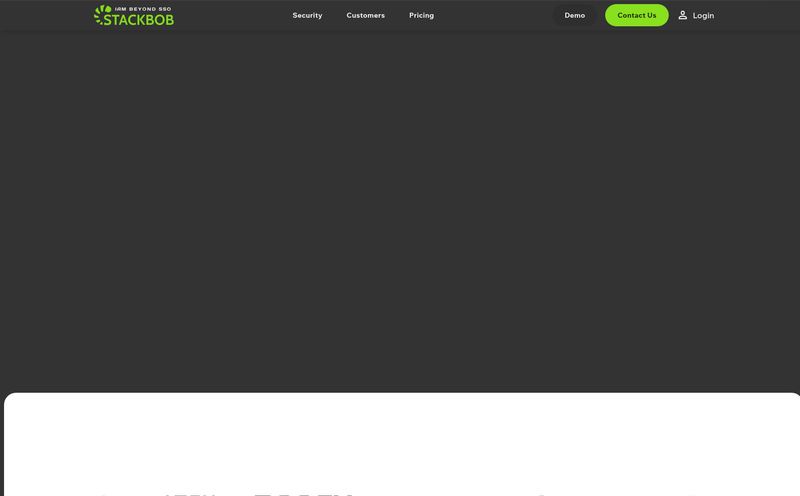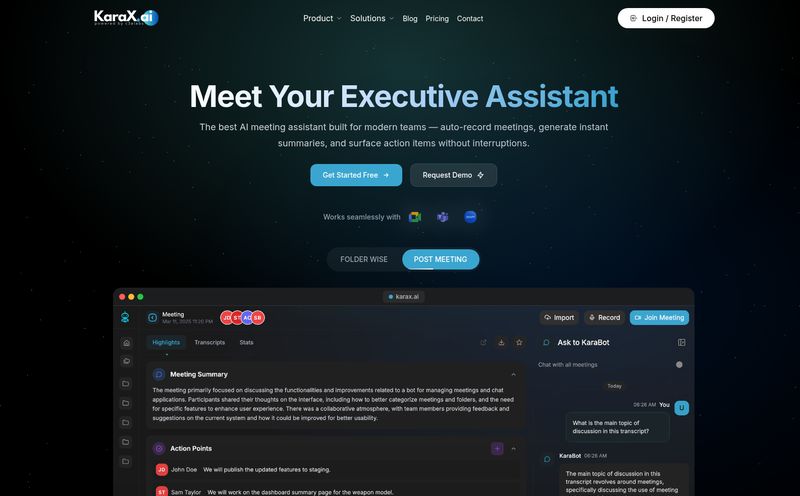Your digital life is a mess. Mine is too. Between the constant Slack pings, the inbox that multiplies like rabbits, and a calendar that looks like a losing game of Tetris, it's a wonder any of us get any real work done. We're all drowning in digital noise, and for years, the promise of a true “personal assistant” has felt like something out of a sci-fi movie.
We’ve tried everything. Complicated productivity systems, endless to-do list apps, even just giving up and accepting chaos as the new normal. But the AI wave is cresting, and with it comes a new generation of tools that are less about adding another app to your stack and more about orchestrating the ones you already have. I've been hearing some chatter in my circles about a new player in this space called Edgar. It's not another task manager. It claims to be an actual AI assistant designed to save you time. A big promise. So, I decided to take a closer look.
So What Exactly Is This Edgar AI Tool?
At its heart, Edgar is an AI assistant built for both your professional and personal life. Think of it less like a simple chatbot and more like a smart, proactive intern who works 24/7, never needs a coffee break, and actually learns your routines. Its whole reason for being is to cut through the noise by automating the repetitive, time-sucking tasks that clog up your day.
It’s designed to connect to your existing tools—your email, your calendar, your cloud storage—and then let you manage them through simple, conversational commands. It’s a powerful idea, and one that could genuinely change teh way we work. No more clicking through five different screens to do one simple thing. You just... ask.
The Core Features That Actually Matter
Any new tool can throw a bunch of features on a landing page. But what actually moves the needle? After digging into Edgar, a few things stood out to me as the real meat and potatoes of the platform.
Intelligent Workflow Automation (The Real Time-Saver)
This is the big one. We’ve had automation tools like Zapier and IFTTT for years, and they're great. But they can be a bit rigid. You set up a specific recipe: “IF this happens, THEN do that.” Edgar’s approach feels a bit more fluid. It’s about creating intelligent workflows. For example, you could tell it, “Hey Edgar, whenever a client emails me a document titled 'Final_Report', save it to my 'Client Reports 2024' folder in Google Drive and send me a Slack notification.”
That’s the kind of multi-step, context-aware automation that starts to feel like true assistance. It’s not just about connecting two apps; it’s about understanding intent and executing a sequence of actions that you would otherwise have to do manually. This is where the real time-saving magic is supposed to happen.

Visit Edgar
Playing Nice with Others Through Integrations
An AI assistant that can’t talk to your other apps is pretty useless. It would be like hiring an assistant who doesn’t have a phone or email. Edgar’s value is directly tied to its ability to integrate with third-party tools. We’re talking about your calendar, email client, cloud storage, and project management software. The goal is to make Edgar the central command hub for your digital life.
Of course, this is a double-edged sword. Its effectiveness is somewhat dependent on the quality and breadth of these integrations, which is something to keep an eye on as the platform develops.
Taming Your Inbox and Calendar
If there are two black holes of productivity, it's email and calendar management. Edgar steps in with features like summarization. Instead of reading a 20-thread email chain, you could just ask Edgar for the highlights. Need to schedule a meeting with three busy people? You can offload that scheduling puzzle to Edgar. It’s like having a press secretary for your own life, filtering the noise and managing the logistics so you can focus on what’s important.
Let's Talk About the Human Touch: NLP and Security
Great features are one thing, but how does it feel to use? And can you trust it? These are two of the most important questions for any AI tool today.
You Can Just... Talk to It
The secret sauce here is Natural Language Processing, or NLP. In plain English, it means you can talk or type to Edgar like you would to a person. You don’t need to learn a bunch of weird slash commands or programming logic. This is huge, because it dramatically lowers the barrier to entry. My grandma might not be able to set up a complex Zap, but she can certainly ask, “What’s on my schedule today?” This conversational interface makes the whole experience feel more intuitive and, well, human.
A Quick Word on Privacy and Security
Handing an AI the keys to your digital kingdom is a big step. I’m naturally skeptical here. We’ve all seen the headlines about data breaches. Edgar’s creators seem to be aware of this, mentioning features like data encryption and an “intelligent privacy filter.” The idea is to keep your sensitive information secure and private. For me, the trust factor is paramount. While they're saying the right things, I'd still advise anyone to be mindful of what permissions they grant, just as you would with any third-party app.
The Good, The Bad, and The AI-Powered
No tool is perfect. After my analysis, here’s my honest breakdown of where I think Edgar shines and where you might want to pause and think.
| What I Liked | What Gives Me Pause |
|---|---|
| Massive Time-Saving Potential: The workflow automation is genuinely compelling. It targets the most tedious parts of office work. | The Initial Setup: This isn't magic. You'll need to invest some time upfront to teach Edgar your workflows and connect your apps. |
| Ease of Use: The natural language interface makes it accessible to people who aren't tech wizards. | The Trust Fall: Relying on an AI with your data requires a leap of faith in its accuracy and security measures. |
| Always-On Availability: Your AI assistant doesn't sleep or take vacations. It's ready to go 24/7. | Integration Dependency: Its usefulness is directly linked to the third-party apps it supports. If it doesn't integrate with your favorite tool, its value drops. |
What's the Damage? A Look at Edgar's Pricing
This is the million-dollar question, isn't it? As of my writing this, Edgar’s pricing structure isn't publicly listed on a simple page. This is pretty common for new tools, especially those that might be targeting teams or enterprise clients before a general public release. They might be operating on a demo-request basis for now.
I would expect a tiered subscription model, perhaps with a free or trial version to let you test the waters, and then paid plans based on the number of workflows or integrations. For now, your best bet is to head over to their official website and see if you can sign up for a waitlist or request a demo. It’s a bit of a mystery, which can be frustrating, but also hints that they might be carefully tuning their offering.
How Does Edgar Stack Up in a Crowded Field?
The productivity space is jam-packed. So where does Edgar fit? It’s not trying to replace a specialized tool like SaneBox for email filtering, or be a pure automation engine like Zapier. Instead, it seems to be positioning itself as the conductor of your digital orchestra. It’s the conversational layer that sits on top of all your other tools, helping them work together more intelligently.
While Siri and Google Assistant are great for setting timers or telling you the weather, Edgar is aimed squarely at complex, multi-step work tasks. It's a subtle but important distinction. It’s built for productivity, not just convenience.
My Final Take on Edgar AI
So, is Edgar the solution to all our productivity woes? Probably not. No single tool can be. But is it a fascinating and promising step in the right direction? Absolutely.
I’m excited by tools that don’t just add another layer of complexity, but instead try to simplify what we already have. Edgar's focus on conversational workflow automation is smart. It targets a real, universal pain point for anyone who works on a computer. The success of this tool will hinge on three things: the depth of its integrations, the robustness of its security, and its ability to be genuinely smarter than a simple set of “if-then” rules.
It might not be for everyone, especially those who have already perfected their own complex systems. But for the chronically busy professional, the small business owner, or anyone who just feels overwhelmed by digital clutter, Edgar is one to watch. It might just be the quiet revolution your workflow has been waiting for.
Frequently Asked Questions About Edgar
Is Edgar AI difficult to set up?
There's likely an initial setup period. While its conversational nature makes it easy to use day-to-day, you'll first need to connect your accounts (like Google Calendar, Slack, etc.) and teach it the specific workflows you want to automate. Expect to invest a little time upfront to get the most out of it.
Can I trust Edgar with my private data?
Edgar's developers claim to use data encryption and privacy filters to protect user information. However, as with any app that accesses your personal or work accounts, it's wise to review their privacy policy and be conscious of the permissions you grant. Trust is a major consideration for any AI tool.
What kind of tools can Edgar integrate with?
The full list of integrations is still growing, but the focus is on core productivity apps. Think email clients (Gmail, Outlook), calendar services, cloud storage (Dropbox, Google Drive), and communication platforms (Slack, Teams). The more integrations it supports, the more powerful it will become.
Is Edgar free to use?
Currently, the pricing information for Edgar isn't public. It's likely to be a subscription-based service, possibly with different tiers of features or a limited free trial. You'll need to check their official site for the most up-to-date information.
How is Edgar different from Siri or Google Assistant?
While Siri and Google Assistant are general-purpose voice assistants good for quick tasks like setting reminders or checking facts, Edgar is a specialized productivity assistant. Its main purpose is to handle complex, multi-step workflows related to your professional life, like managing documents, summarizing emails, and coordinating schedules.
Reference and Sources
- The rise of workflow automation - An insightful look from Ness Labs on how automation is changing personal productivity.
- What is Natural Language Processing (NLP)? - A good primer from TechTarget on the technology that powers conversational AI.
- Navigating AI and Data Privacy - A WIRED article discussing the broader concerns around AI and personal data security.



